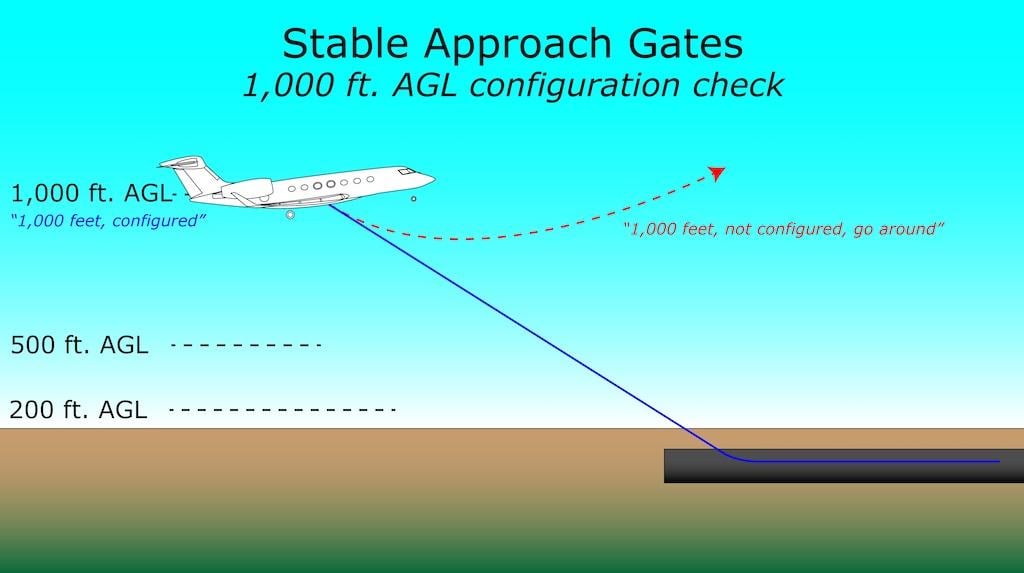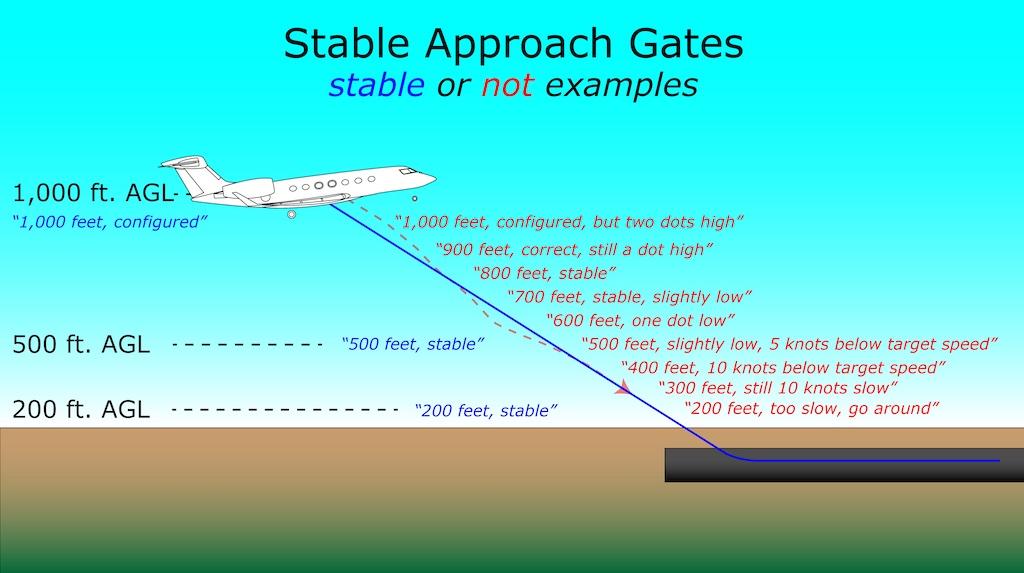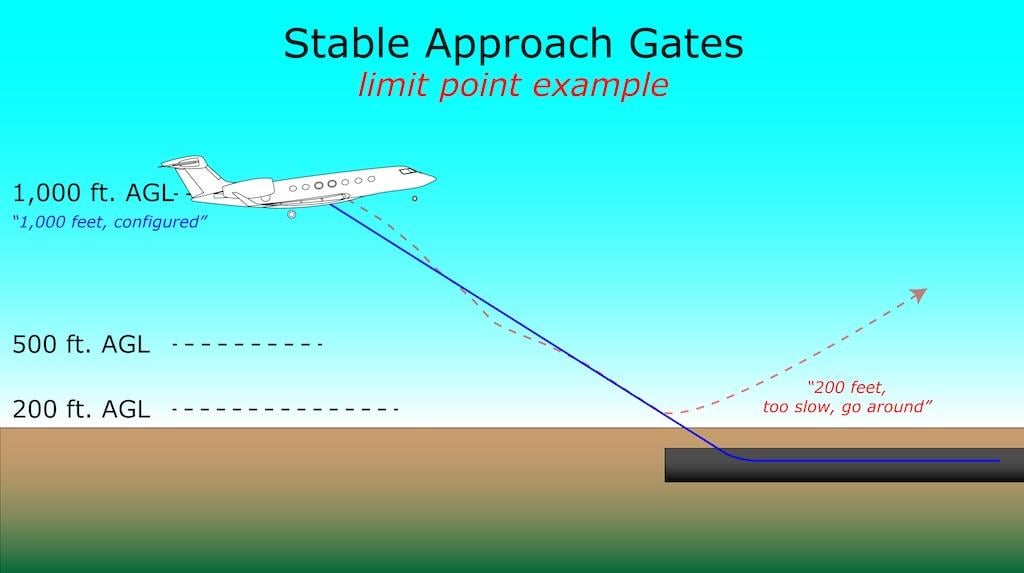
In the first two parts of this article, we discussed why pilots fail to go around when their Standard Operating Procedures (SOP) tell them to. In this final part, we’ll discuss the three steps to achieving a stabilized approach.
Step 1: Apply Three Approach Gates
One of the problems with the previous rationale of a stabilization height of either 1,000 ft. IMC or 500 ft. VMC, below which a go-around must be executed, is that many pilots do not believe an approach is “beyond saving” at that point. The “do or die” status of those heights became non-credible. The newer methodology establishes three approach gates where different items are evaluated, crew interaction is increased, and the point at which a go-around must be initiated is lowered. You can (and should) go around earlier if the need arises, but the “must” point is lower.
*Configuration gate, conducted between 800 and 1,500 ft. I’ve selected 1,000 ft. This is the point at which the final configuration of the aircraft (i.e., gear and flaps) must have been selected. This is done earliest since it takes time for the landing gear and flaps to move, and we quite often cannot decelerate to our final approach speed until the last notch of flaps is extended. The Flight Safety Foundation study says most aircraft can only slow between 10 and 20 kt. per nautical mile, so 1,000 ft. might be too low for some, but it looks right for my aircraft. At this point the callout would be, “1,000 ft., configured.” The study does not mandate a go-around at this point if not configured, but I think that would be my choice.
- Five-hundred-foot gate. This gate is used to check all stable approach criteria. The criteria should be delineated in company SOPs. See “The Recommended Elements of a Stabilized Approach” sidebar for an example list.
- Two-hundred-foot gate. The study uses a 300-ft. gate, but we’ve opted for 200 ft. to coincide with typical ILS minimums. (We regularly practice missed approaches from this height.) This gate differentiates between approach stability and a go-around decision. The study strongly recommends a go-around be executed if the approach is unstable at this point.
There is much more to this technique than replacing one gate with three. If you are not stable below the 1,000-ft. and 500-ft. gates, a go-around is not mandated. Instead, the pilot monitoring (PM) starts a “play-by-play” callout of what is wrong, reminding the pilot flying (PF) that something needs to change if the approach is to continue.
Step 2: Use Callouts Throughout to Confirm the Approach is Stable or to Warn That It Is Not

If the approach begins and remains stable, the PM calls out that fact at 1,000 ft., 500 ft. and 200 ft. Otherwise, passing 1,000 ft. AGL, the PM starts to call out what is wrong every hundred feet until a 200-ft. limit point. The study doesn’t specify every 100 ft., but given that you descend through 100 ft. every 10 sec. on a 600-fpm approach, it seems about right to me. (It takes a second to make the callout.) The callouts are necessary even when everything is stable because the crew should be practiced at making the calls. I long ago grew accustomed to complete silence in the cockpit once the aircraft was configured, and only grudgingly accepted the bare minimum of altitude callouts.
But over the years, watching the normalization of unstable approaches, I see the value in a good play-by-play.
Let’s say everything is just as it should be. You can expect a “configured” call at 1,000 ft., and two “stable” calls at 500 ft. and 200 ft. AGL. But now let’s say you start too high on glidepath, correct but overcorrect and end up too low. Then, just as you reach 500 ft., you manage to correct back to glidepath but start losing speed. The play-by-play lets you know things are not going smoothly well in advance. If you get to the 200-ft. point and things are back to normal, you land. But if they aren’t, the “go around” call will not be a surprise.
Step 3: Use a Limit Altitude to Point Out When a Go-Around Decision Must Be Made

Before every safety officer in the country assails me for advocating there is no need to go around until just 200 ft. above the runway, allow me to emphasize the 200-ft. gate is a limit. There are times a go-around should be initiated even before the 1,000-ft. gate. The Burbank Southwest Airlines flight, for example, crossed 1,000 ft. more than 50-kt. too fast with less than their final flap setting because they were faster than the flap limiting speed. They were descending at three times the stable approach limit, their throttles were at idle, and the GPWS repeatedly announced “SINK RATE” and “PULL UP.” Looking at their approach profile from the safety and comfort of an armchair, as armchair quarterbacks are wont to do, they should have gone around at 3,000 ft. If you do, however, insist that every violation of stable approach criterion be treated with a go-around, consider the risk of an unplanned go-around into a busy traffic pattern because the aircraft was 10-kt. fast or still rolling out of a bank at 500 ft. Clearly, not all unstable approaches are created equally.
As is true with the conventional 1,000-ft./500-ft. methodology, there comes a time when the callouts come to an end, provided the landing is deemed stable enough to land. But that doesn’t mean the need for a go-around comes to an end. When designing your stable approach SOP, you should keep in mind that the risks associated with a go-around go up as the altitude goes down.
I am comfortable with the 200-ft. limit gate, but I’ve heard other operators use higher and lower heights. Whether or not you opt for a lower height, you should consider the risks associated with having to outclimb nearby obstacles from a lower altitude, the problems associated with engine spool-up time, and the ability of your aircraft to overcome the challenges of climbing out of ground effect. For more about the problems with these types of go-arounds, see my article, “Balked Landings,” in the September 2021 issue of BCA.
Flight Department Buy-In
The biggest advantage to this three-step method is that it more realistically tracks pilot expectations and is therefore more credible. If you plan on adopting a form of this technique, you should fully discuss it among all pilots in your group to obtain genuine “buy in.” As the study makes clear, the SOP can only be effective when it is “written clearly, explained thoroughly, commonly understood and voluntarily complied with.”
So, is this just another attempt at making stable approaches more palatable by gently massaging the procedures and callouts? I don’t think so. The play-by-play perfectly addresses my biggest weakness when it comes to stable approaches. It reminds me early that the other pilot is watching and reporting for us both (and the cockpit voice recorder) how things are going. It should spur me into not accepting my performance as “close enough.” It speaks to that inner voice that says to me, “I can save this.” And if I don’t, it steels the PM’s nerves to say “go around” while preparing me to receive those instructions and act on them.
The NTSB has never reviewed the CVR and FDR on any of my flights. This technique will help me stop them from ever having to.
Three Steps To Stabilized Approaches, Part 2: https://aviationweek.com/business-aviation/safety-ops-regulation/three-…





